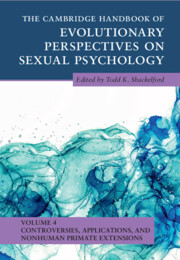Book contents
- The Cambridge Handbook of Evolutionary Perspectives on Sexual Psychology
- The Cambridge Handbook of Evolutionary Perspectives on Sexual Psychology
- Copyright page
- Contents
- Contributors
- Preface
- Part I Controversies and Unresolved Issues
- Part II Applications to Health, Law, and Pornography
- Part III Nonhuman Primate Sexual Behavior
- 14 Chimpanzee Sexual Behavior
- 15 Bonobo Sexual Behavior and Psychology
- 16 Orangutan Sexual Behavior
- 17 Gibbon Evolved Sexual Psychology
- 18 Sexual Behavior in Marmosets in the Context of Cooperative Breeding
- 19 Capuchin Sexual Behavior
- 20 Sexual Behavior in Neanderthals
- Index
- References
14 - Chimpanzee Sexual Behavior
from Part III - Nonhuman Primate Sexual Behavior
Published online by Cambridge University Press: 30 June 2022
- The Cambridge Handbook of Evolutionary Perspectives on Sexual Psychology
- The Cambridge Handbook of Evolutionary Perspectives on Sexual Psychology
- Copyright page
- Contents
- Contributors
- Preface
- Part I Controversies and Unresolved Issues
- Part II Applications to Health, Law, and Pornography
- Part III Nonhuman Primate Sexual Behavior
- 14 Chimpanzee Sexual Behavior
- 15 Bonobo Sexual Behavior and Psychology
- 16 Orangutan Sexual Behavior
- 17 Gibbon Evolved Sexual Psychology
- 18 Sexual Behavior in Marmosets in the Context of Cooperative Breeding
- 19 Capuchin Sexual Behavior
- 20 Sexual Behavior in Neanderthals
- Index
- References
Summary
To understand the sexual behavior of chimpanzees (Pan troglodytes), we must focus on factors such as physiological characteristics, ecological constraints, and the different social behaviors found in individual groups. This chapter provides an overview of some central ideas in the study of chimpanzee sexual behavior. We begin with an overview of the main physiological characteristics of chimpanzees, including the characteristic sexual swelling (i.e., pronounced perineal swelling during the estrous period of females) and the complex behavioral patterns around these physiological characteristics. Then we consider the different sexual behaviors observed across different sites. These descriptions include several categories of behaviors commonly observed, such as courtship behavior, consortship, sexual interference, and mating calls. We include, when appropriate, a description of the different ways in which these behaviors are displayed by males and females and by mature and immature individuals. Then we examine the interplay among sexual behavior, social patterns, and natural selection. We examine how understanding sexual behavior in the context of sexual selection helps us appreciate the interactions that occur in mating, including the relationship between rank and mating choices. This section includes a brief discussion of how rearing conditions, in particular isolation and human-rearing, influence the development of sexual behavior in chimpanzees. Next, this chapter provides examples of variations in sexual behaviors across different chimpanzee communities. The aim of this section is twofold, first, to show how, despite similarities across groups, we must be careful when asserting generalizations about chimpanzee sexual behavior and, second, to underscore the importance of considering variation across different sites so that we can obtain a more accurate picture of sexual behavior. Finally, we provide a brief discussion of the limitations of using chimpanzee sexual behavior to understand the evolution of human sexual behavior. Despite the origins of the study of chimpanzee sexual behavior as a tool to understand the evolution of human sexual behavior, it is necessary to recognize the limitations of extrapolating from chimpanzee sexual behavior to human sexual behavior. Given the ecological differences among these two species and variations among different populations of chimpanzees, extrapolations must acknowledge potential differences.
- Type
- Chapter
- Information
- Publisher: Cambridge University PressPrint publication year: 2022



